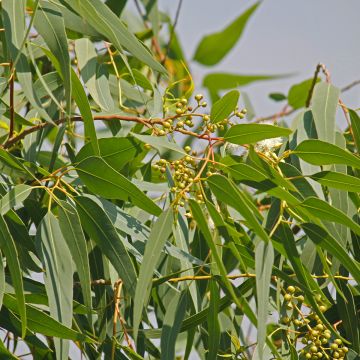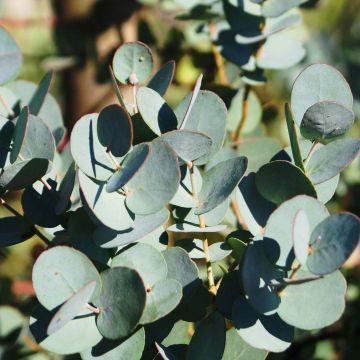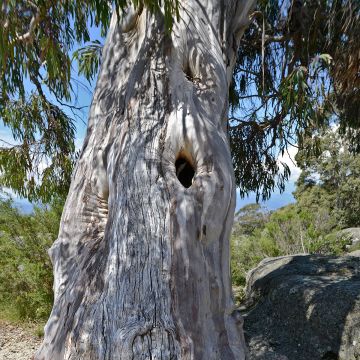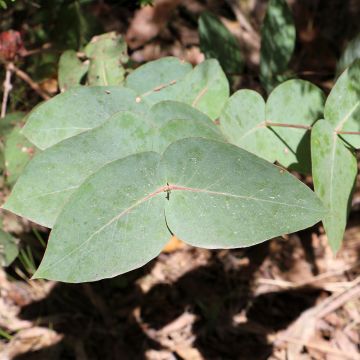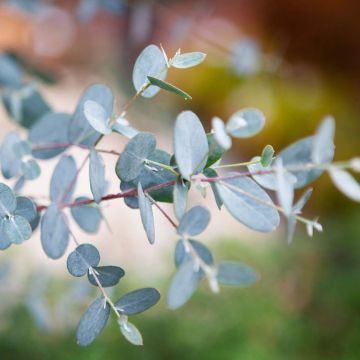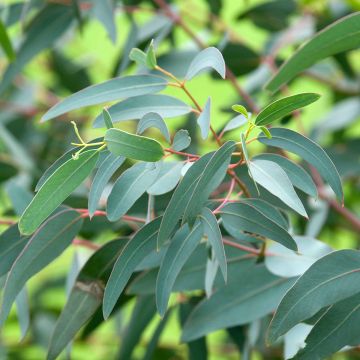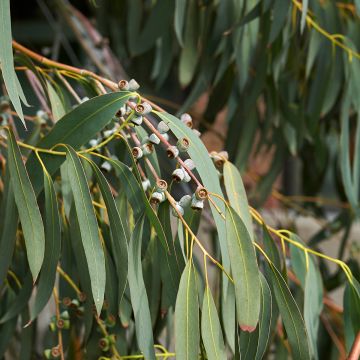Shipping country and language
Your country of residence may be:
Your country of residence is:
For a better user experience on our website, you can select:
Your shipping country:
Andorra
Austria
Belgium
Bulgaria
Canada
Chile
Croatia
Cyprus
Czechia
Denmark
Estonia
Finland
France
Germany
Greece
Hungary
Iceland
Ireland
Italy
Latvia
Lithuania
Luxembourg
Malta
Monaco
Netherlands
Poland
Portugal
Romania
Slovakia
Slovenia
Spain
Sweden
Switzerland
United Kingdom
We only deliver seed and bulb products to your country. If you add other products to your basket, they cannot be shipped.
Language:
French
German
Spanish
English
My Account
Hello
My wish lists
Plantfit
Log in / Register
Existing customer?
New customer?
Create an account to track your orders, access our customer service and, if you wish, make the most of our upcoming offers.


Eucalyptus coccifera


Eucalyptus coccifera
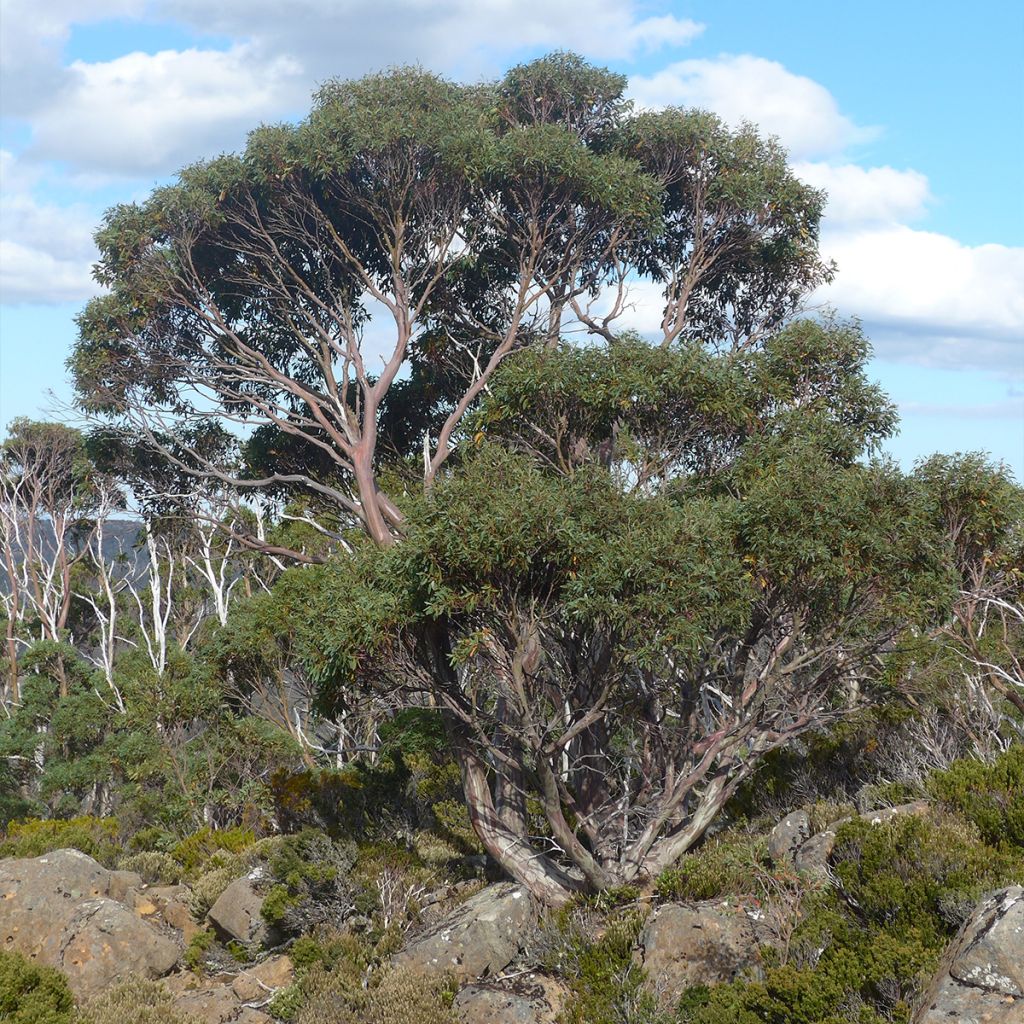

Eucalyptus coccifera
Eucalyptus coccifera
Eucalyptus coccifera Mt Field
Tasmanian Snow Gum, Mount Wellington Peppermint
Why not try an alternative variety in stock?
View all →Order in the next for dispatch today!
Dispatch by letter from €3.90.
Delivery charge from €5.90 Oversize package delivery charge from €6.90.
More information
This item is not available in your country.
Schedule delivery date,
and select date in basket
This plant carries a 24 months recovery warranty
More information
We guarantee the quality of our plants for a full growing cycle, and will replace at our expense any plant that fails to recover under normal climatic and planting conditions.
From €5.90 for pickup delivery and €6.90 for home delivery
Express home delivery from €8.90.
Does this plant fit my garden?
Set up your Plantfit profile →
Description
Eucalyptus coccifera, nicknamed the Tasmanian Snow Gum, stands out for its original stature, its highly decorative bark and its elegant and refined foliage. It is a tree with a variable habit, with low-growth specimens (5 to 6 m (16 ft 5 in to 19 ft 8 in)), spreading and branching on several trunks, and larger specimens (10 to 15m (32 ft 10 in to 49 ft 2 in)) which are slender on a single trunk. From this, different uses are derived according to the size of the garden and the desired architecture. The young, very colourful and aromatic foliage, is appreciated in floral composition. Native to the cold, mountainous regions of Tasmania, it is capable of resisting cold down to -12°C (10.4 °F), snow for several weeks, strong winds and sea spray. It dislikes dry conditions and its installation in the garden requires the choice of a suitable location, in moist and draining soil, in the sun.
Eucalyptus coccifera is an endemic species from Tasmania (Australia) where it is present on the high plateaus and alpine regions, notably from the Mount Field National Park, where Mount Field dominates at 1434m (4704 ft 8 in) altitude, and from the Mount Wellington region, southeast. On wind-swept alpine crests and heathlands, this dominant species grows almost exclusively above the forest limit, at altitudes between 700 and 1200 metres (2296 feet 7 inches and 3937 feet). It thrives on poor and draining soils, composed of dolerite (magmatic rock). In these mountainous regions, the climate is strongly influenced by the sea, which gives a cold atmosphere in winter (5 to 12°C (41 to 53.6 °F)) and mild to cool in summer (10 to 22°C (50 to 71.6 °F)), with precipitation of 1000 mm spread over all months of the year. Belonging to the Myrtaceae family, it is commonly called: Tasmanian Snow Gum or Mount Wellington Peppermint.
This eucalyptus can form a tree on a trunk with a rounded top 15 m (49 ft 2 in) high or a mallee of 5 to 6 m (16 ft 5 in to 19 ft 8 in) developing, branching into several beautiful branches with a twisted effect, forming a spreading and rounded shape. The term mallee determines the stature of a eucalyptus, formed by several stems starting from the soil, reaching a height less than 10 metres (32 feet 10 inches). With a rather slow growth, the Snow Gum, on one or several stems, starts from a stump called lignotuber* located just below the surface of the soil. When young, it displays rounded and warty branches, bearing juvenile foliage, composed of opposite, elliptical to cordate, blue-green leaves, 1.5 to 4.5 cm (0.6 to 1.8 in) long and 1 to 2.5 cm (0.4 to 1 in) wide. Then, as it develops, the leaves are alternate and take a lanceolate shape 5 to 10 cm (2 to 3.9 in) long and 1 to 2 cm (0.4 to 0.8 in) wide, of a pretty shiny blue-green, on both sides. The leaves are very aromatic and release a menthol fragrance when crushed, rich in eucalyptol. With age, the bark becomes smooth, and marbled with bands of incredible shades of grey, cream, white, pink, brown or orange. The flowering mainly occurs in the summer period, but occasionally at other times. The inflorescence, arranged in the axil of the leaves, on a short peduncle, is composed of 3, 7 or 9 floral buds gathered in a tight bunch and blooms into small flowers with numerous cream-white anthers, forming a pompom, about 2 cm (0.8 in) in diameter. Rich in nectar, they are very attractive to bees and birds. After flowering, the fruits, called "gumnut", appear in the form of a woody, hemispherical or cup-shaped capsule which contains brown seeds 1.5 to 2 mm (0.1 to 0.1 in) long.
This eucalyptus has a *lignotuber, constituted by a swelling rich in starch that forms on the roots just below the surface of the soil. This organ allows it to start again from the stump in case of severe frost, fire or severe pruning. The plant also produces many shoots from dormant buds located under its bark, which allows it to respond well to pollarding, topping or more severe pruning.
The Tasmanian Snow Gum is an attractive and robust tree that finds a place planted as a standalone in a clear space to appreciate the beauty of its bark and the elegance of its stature. Supporting pruning well, it can be grown on a single trunk to form a slender tree or on multiple trunks to form a more spreading plant, but more contained, suitable for small gardens. With a hardiness of -10 to -12° (14 to 10.4 °F) C, it will prefer a temperate, coastal climate with dry to moist, well-draining soils, it dislikes periods of long droughts and soils that are too clayey or chalky. Comfortable in wet, but not swampy, soil, it has the capacity to dry them out. With a very developed root system, one must be vigilant about the choice of its location, keeping it away from the foundations of a house or pipelines.
Eucalyptus coccifera in pictures




Plant habit
Flowering
Foliage
Botanical data
Eucalyptus
coccifera
Mt Field
Myrtaceae
Tasmanian Snow Gum, Mount Wellington Peppermint
Australia
Planting and care
Eucalyptus coccifera Mt Field is best planted at the beginning of spring in cold regions, and the start of autumn in dry and hot climates. Plant in well-prepared soil, not too dry to moist, in a very sunny situation. Clayey or silty, even chalky, soils are well tolerated. A well-established specimen is hardy down to -12 °C in these conditions and will tolerate snow. Young plants are more sensitive to severe frosts, especially if the frost sets in for several days and the soil is damp. In most regions, you can plant it in the open ground, ensuring good drainage by adding coarse sand, pozzolana or non-limestone gravel. Then let nature take its course, the growth is quite rapid.
For the first two years, regular watering is necessary then the bush can do without watering in summer. Fertilizer is not recommended. Pruning is not necessary, but it is well tolerated after flowering or at the end of winter if the stems have frozen. You can train the eucalyptus into multiple trunks or on a single trunk, by selecting the best placed one and cutting all the others flush. And it is quite possible to coppice this small tree to form a large bush whose height you can limit.
Gum trees are useful for drying out wet land, as they are big water consumers even in winter. However, they become quite resistant to drought once well established (depending on the species and varieties).
Young plants take root most easily in the open ground. The deep root system of the Eucalyptus does not like to be disturbed. Choose its location carefully as it will be permanent.
Montain species are useful for their hardiness, but they don't like heat waves and soils that are too dry.
Planting period
Intended location
Care
This item has not been reviewed yet - be the first to leave a review about it.
Haven't found what you were looking for?
Hardiness is the lowest winter temperature a plant can endure without suffering serious damage or even dying. However, hardiness is affected by location (a sheltered area, such as a patio), protection (winter cover) and soil type (hardiness is improved by well-drained soil).

Photo Sharing Terms & Conditions
In order to encourage gardeners to interact and share their experiences, Promesse de fleurs offers various media enabling content to be uploaded onto its Site - in particular via the ‘Photo sharing’ module.
The User agrees to refrain from:
- Posting any content that is illegal, prejudicial, insulting, racist, inciteful to hatred, revisionist, contrary to public decency, that infringes on privacy or on the privacy rights of third parties, in particular the publicity rights of persons and goods, intellectual property rights, or the right to privacy.
- Submitting content on behalf of a third party;
- Impersonate the identity of a third party and/or publish any personal information about a third party;
In general, the User undertakes to refrain from any unethical behaviour.
All Content (in particular text, comments, files, images, photos, videos, creative works, etc.), which may be subject to property or intellectual property rights, image or other private rights, shall remain the property of the User, subject to the limited rights granted by the terms of the licence granted by Promesse de fleurs as stated below. Users are at liberty to publish or not to publish such Content on the Site, notably via the ‘Photo Sharing’ facility, and accept that this Content shall be made public and freely accessible, notably on the Internet.
Users further acknowledge, undertake to have ,and guarantee that they hold all necessary rights and permissions to publish such material on the Site, in particular with regard to the legislation in force pertaining to any privacy, property, intellectual property, image, or contractual rights, or rights of any other nature. By publishing such Content on the Site, Users acknowledge accepting full liability as publishers of the Content within the meaning of the law, and grant Promesse de fleurs, free of charge, an inclusive, worldwide licence for the said Content for the entire duration of its publication, including all reproduction, representation, up/downloading, displaying, performing, transmission, and storage rights.
Users also grant permission for their name to be linked to the Content and accept that this link may not always be made available.
By engaging in posting material, Users consent to their Content becoming automatically accessible on the Internet, in particular on other sites and/or blogs and/or web pages of the Promesse de fleurs site, including in particular social pages and the Promesse de fleurs catalogue.
Users may secure the removal of entrusted content free of charge by issuing a simple request via our contact form.
The flowering period indicated on our website applies to countries and regions located in USDA zone 8 (France, the United Kingdom, Ireland, the Netherlands, etc.)
It will vary according to where you live:
- In zones 9 to 10 (Italy, Spain, Greece, etc.), flowering will occur about 2 to 4 weeks earlier.
- In zones 6 to 7 (Germany, Poland, Slovenia, and lower mountainous regions), flowering will be delayed by 2 to 3 weeks.
- In zone 5 (Central Europe, Scandinavia), blooming will be delayed by 3 to 5 weeks.
In temperate climates, pruning of spring-flowering shrubs (forsythia, spireas, etc.) should be done just after flowering.
Pruning of summer-flowering shrubs (Indian Lilac, Perovskia, etc.) can be done in winter or spring.
In cold regions as well as with frost-sensitive plants, avoid pruning too early when severe frosts may still occur.
The planting period indicated on our website applies to countries and regions located in USDA zone 8 (France, United Kingdom, Ireland, Netherlands).
It will vary according to where you live:
- In Mediterranean zones (Marseille, Madrid, Milan, etc.), autumn and winter are the best planting periods.
- In continental zones (Strasbourg, Munich, Vienna, etc.), delay planting by 2 to 3 weeks in spring and bring it forward by 2 to 4 weeks in autumn.
- In mountainous regions (the Alps, Pyrenees, Carpathians, etc.), it is best to plant in late spring (May-June) or late summer (August-September).
The harvesting period indicated on our website applies to countries and regions in USDA zone 8 (France, England, Ireland, the Netherlands).
In colder areas (Scandinavia, Poland, Austria...) fruit and vegetable harvests are likely to be delayed by 3-4 weeks.
In warmer areas (Italy, Spain, Greece, etc.), harvesting will probably take place earlier, depending on weather conditions.
The sowing periods indicated on our website apply to countries and regions within USDA Zone 8 (France, UK, Ireland, Netherlands).
In colder areas (Scandinavia, Poland, Austria...), delay any outdoor sowing by 3-4 weeks, or sow under glass.
In warmer climes (Italy, Spain, Greece, etc.), bring outdoor sowing forward by a few weeks.
